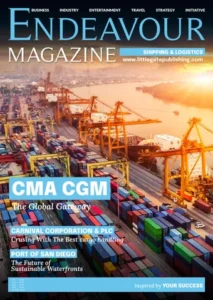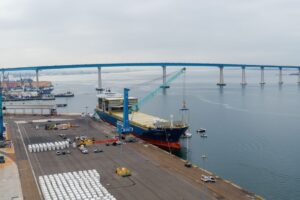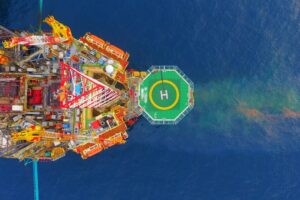From its home on the western shore of Lake Michigan, the Port of Milwaukee is a vital hub for shipping operations connecting Wisconsin with important markets across the US and along international shipping routes. The port’s central mission is to enhance the economic and social well-being of the city through trade, business, and employment supported by its port activities, which position the state as a leading centre for domestic and international transportation and freight distribution services. Handling approximately 2.3 million metric tons of cargo annually, it has continued to strengthen its reputation as a key player in the state’s trade, helping to maintain Milwaukee as a water-centric city, where businesses and communities thrive thanks to the port’s maritime operations.
Check out the article in the magazine below:
The Port of Milwaukee, overseen by a seven-member board of Harbour Commissioners, aims to foster shipping and economic development in Wisconsin and neighbouring states through its top-tier domestic and international transportation and freight services. The Port can accommodate vessels up to a maximum draft of 8.08 metres under normal water conditions and up to 304.8 metres in length. Additionally, the port features two dedicated barge berths with drafts exceeding 5.5 metres. These facilities ensure the port can efficiently manage cargo from both local and international clients.
Vessels arriving at the Port of Milwaukee gain access to a range of services to offload and unload cargo across 330,000 square feet (sq. ft) of covered warehouse space. This is specifically designed for bulk, steel and general cargo, but there is also 30,000 sq. ft of climate-controlled space should a customer’s cargo require it. This space is utilised by customers spanning a multitude of industries, with common good transported including steel, wind turbine components, brewery tanks, mining equipment, yachts, forest products, transformers, farm equipment, construction machinery, manufacturing equipment, bagged materials and other project cargoes. With such a vast array of products moving through the port, we can begin to understand just how vital the Port of Milwaukee is in supporting these industries, and in turn, the local and national economy.
One of the main reasons the port can support such a variety of cargoes is due to the commercial operational flexibility of the port, which is unique to the Western Great Lakes and the St. Lawrence Seaway inland waterway system. This is largely aided by the Port’s location, which allows it to serve primary markets across the State of Wisconsin, as well as northern and western Illinois, and eastern Minnesota via both road and rail services. The Port benefits from its proximity to railroad links, which provide the port with the valuable infrastructure to get cargo moving from the port and across the country seamlessly. The Port of Milwaukee is served by two Class I railroads: the Union Pacific (UP) Railway and the Canadian Pacific Kansas City (CPKC) Railway. These provide an essential link to other states, and so vessels stopping in Milwaukee can use the port to distribute their products throughout the region and onto the national marketplace. This reliance on the railroad infrastructure has been further developed by the Port of Milwaukee as it also owns and maintains 14 miles of its own rail track, which connects up with the UP and CPKC railways.
In addition to the railroads, the Port of Milwaukee is also directly served by the Federal Interstate Highway System with the I-94/794, which allows trucks to drive directly into the port. This ease of access to the port for the land freight forwarders and trucking companies allows for a quicker turnaround on shipment pick-ups and therefore a speedy delivery to customers. Consequently, through almost 350 miles of highway connection, the Port of Milwaukee provides direct access from its ports to crucial trade hubs such as Chicago, Minneapolis, St. Paul, Peoria, Des Moines, Moline, Indianapolis, Madison and Green Bay.
Ultimately, what continues to make the Port of Milwaukee so successful on a wide scale is its network of transportation professionals across the region. This includes everyone from vessel and barge owners to rail operators, freight forwarders, customs brokers, and other beneficial owners of cargo. Collectively, this network helps deliver the integrated transportation network across the state to help the Port continually meet its logistics and shipping needs. With such a vast network, it’s no surprise that the Port’s operations have reaped significant economic benefits both to people and the local economy, with more than 1,300 jobs created through the port, and $155.7 million generated in economic activity, with $100.3 million in income generation. Thus, in its commitment to stimulating trade on both a local and international scale, the port continues to be largely successful in delivering vital benefits for all those involved.
Aside from cargo and the State’s import and export activities, the Port is also home to a thriving tourism sector, which sees thousands of global passengers descend on the port annually. For the Port of Milwaukee, it aims to be a premier destination for tourists seeking a diverse and vibrant travel experience. Cruise tourism is vital for bringing significant economic benefits to the local economy, and the cruise business of the Port of Milwaukee is no exception. Every year, multiple different cruise companies arrive at the Port on travel itineraries that include Milwaukee. The typical cruise season spans from late April until mid-October, and so the 2025 cruise season for the Port of Milwaukee is well underway. The inaugural cruise ship to call at the City of Milwaukee for the 2025 season was Viking Octantis, marking it as the fourth consecutive year this vessel has opened the cruise season for the port.
Over the upcoming season, the Port of Milwaukee expects around 22 cruise vessels to arrive at the port, spanning 44 itineraries. These calls are estimated to bring around 11,000 global passengers to Milwaukee, providing a significant benefit to the local economy. Other vessels arriving at the Port this season will include Viking Polaris, Pearl Mist, and, after a 7-year hiatus, the port will see a return from cruise vessels from Victory Cruise Lines. What we can see across the Port of Milwaukee’s cruise services is that the tourism sector is vital for the local economy, and with the repeated arrival of giant cruise liner companies such as Viking and Pearl Seas to the shores of Milwaukee, it is an industry that will continue to expand. Thus, with the vital infrastructure and services in place, the port is primed with the expertise to service these vessels, bringing benefits to both its visitors, local economy and the port, thanks to its growing reputation as a leading cruise port of call.
From cargo movement to cruise itineraries, the Port of Milwaukee is primed to be a leading hub for maritime activities located at the heart of the Midwest of the US. As the Port moves towards the future, it will continue to expand on its port offerings to enhance its delivery of maritime services and help it to keep cargo moving, supported by its integrated infrastructure to boost local and international trade for many years to come.








